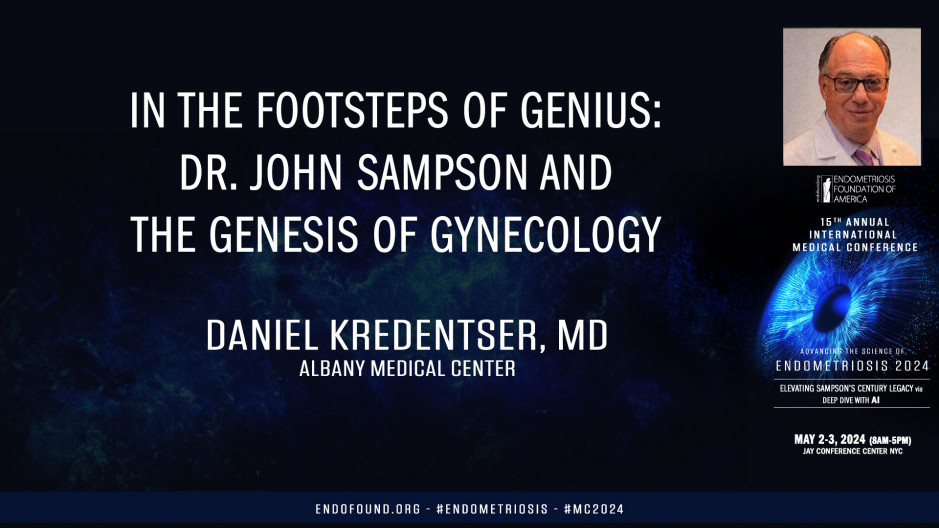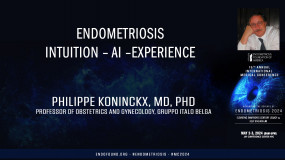International Medical Conference
Endometriosis 2024:
Elevating Sampson’s Century Legacy via
Deep Dive with AI
For the benefit of Endometriosis Foundation of America (EndoFound)
May 2-3, 2024 - JAY CENTER (Paris Room) - NYC
Thank you very much. I think one of the biggest honors in my life was being named Professor Emeritus of GI Oncology. And following in Dr. Sampson's footsteps,
I,
And I know that you all know Dr. Sampson as the father of endometriosis, but I hope by the end of this short talk, okay, by the end of this short talk, you'll appreciate the genius of this extraordinary man and understand his legacy. So just to raise some background, Dr. Sampson was born in 1873 in Brunswick, New York, approximately 10 miles northeast of Albany Medical Center. He attended Troy Academy and then Williams College in Williamstown, Massachusetts. He entered Johns Hopkins School of Medicine in 1895, graduated CU Laude in 1899 in their third medical class. Should note that Johns Hopkins Hospital was started in 1889 in 1900. Dr. Sampson began his residency at Johns Hopkins under Dr. Howard Kelly, another giant in our field. And you may know him from the Kelly Clamp. Over his career. Dr. Sampson published 67 articles, all but two as the sole author. Interestingly, Dr. S Samson trained at a time when gynecologists did their own pathology. Upon completion of his residency in 1905, Dr. Samson moved to Albany, New York, where he continued to practice for the next 40 years. He was the first chairman of the department of OB, GYN, at Albany Medical College and Hospital. Prior to that, the Department of Gynecology was part of the Department of Surgery
Carcinoma. The cervix was the focus of Dr. Sampson's early career. During his residency, he published 18 articles on cervical cancer based on a systematic examination of multiple surgical specimens. The first article in 1902 discussed that type five extended radical hysterectomy to ensure removal of the entire cancer room. Remember, this was prior to radiation therapy, which was first applied in 1903. And during their surgery, you have to remember, they were using drop ether. There were no IVs, no blood transfusion. I mean, it was remarkable. So when these procedures, Dr. Sampson and colleagues removed the distal ureters plus or minus the bladder, and they prefer Neos in five subsequent articles published in 1904. Now he's a resident senior resident. He published five articles in 1904, and they're long. He discussed the relationship of the ureters, the bladder, and the rectum to the cervical cancer, and also their relationship to the radical surgical procedures. The last article here describes the pathogenesis in the step-by-step repair vesicle vaginal fistulas. If you ever want to read, a nice surgical article is well written. So this all culminated in this summary article. This was delivered at the American Medical Society in 1904. Again, he was a fourth year resident.
At the same meeting, he also delivered this treatise to the pathology section describing the ureteric sheath in its relation to carcinoma the cervix. Dr. Stamps did extensive research on the ureter in 1904, and this research is still some of the basis for urologic teaching. This paper became the definitive article on the blood supply to the ureter. By injecting the various arteries, he demonstrated the arterial plexus from the kidney to the bladder. And Dr. Sampson illustrated his own articles. And these were his illustrations from that article on the blood supply
In a paper delivered in 1905 to the gynecologic section of the International Congress of Arts and Sciences in St. Louis, Dr. S Samson discussed the importance of early diagnosis and improving prognosis for cancer, the cervix, he pointed out the barriers to early diagnosis, patient ignorance, poverty and race, failure of physicians to even bother to examine their patients. And then he talked about tumor growth patterns that did not give rise to early symptoms. And just to contrast that, this is a paper delivered this year at the SGO annual meeting, which basically says the same thing 120 years later. So mind me if I'm not impressed, this paper was a study of the pum. In carcinoma of the cervix was Dr. S Samson's thesis. As he finished his residency, he expanded his investigation at this time to 27 patients. And those are his illustrations from that paper. At Albany madd, Dr. S Samson continued investigating a variety of topics. There are several on the blood supply of the uterus, tubes and ovaries. But the most important is the last article written in 1917 where he showed particles escaping from the uterine cavity into the venous lymphatic channels, but only during menstruation. This became important later in his theory regarding the origin of endometriosis.
And these are the radiographs from his articles regarding blood supply to the uterus and the ovary in them, he injected SMUs into the uterine arteries of autopsy specimens and then took the radiographs. Dr. Sampson's expertise was widely acknowledged during his lifetime. These radiographs of Dr. Sampson's were published in the 1917 Northwestern Annual update in Practical Medicine gynecology. And these were actually a term stillborn. Well, 1921. This is why we are you are all gathered here. Date on Dr. Sampson perforating hemorrhagic cysts of the ovary. This is a long article which I've distilled down for brevity, although I'll say most of those articles were extremely long. They're like 50 pages with illustrations. I mean, I don't know how they were ever published, but all of you recognize the gross description that he wrote here. Dense, adherent, easily ruptured chocolate filled cyst adhesions that sometimes simulate malignancy. I will tell you it's A GYN oncologist. I'd rather operate on cancer than bad endometriosis. And the microscopic description cyst lined by epithelium, resting on vascular stroma, sometimes containing gland like structures resembling endometrial glands, old hemorrhage. This definition continues to be the standard today. So this was the first in a series of 18 articles of endometriosis written by Dr. Sampson over his lifetime.
And he felt that this time that the X extra ovarian lesions were a result of implantation following cyst rupture. And he referred to this later as his first step in these two landmark articles from 1922, Dr. S Samson describes two important concepts in the first he describes retrograde menstruation as he had noticed numerous cases of endometriosis where the ovaries did not contain chocolate cysts. And in the second he noted that endometriosis lesions react to life events in a similar manner as the mucosa of the uterine cavity. And this was extremely important. Later in 1925, Dr. Sampson uses the term endometriosis for the first time, and he said the term endometriosis is more descriptive than osis. And I still can't say malaria noses. I can't say it. It's just too much. And these were illustrations of gross findings with the photo micrographs that were attached. Up until 1921. Dr. Sampson did all of his own illustrations for his articles. But starting in 1921, they were done by Miriam Ruth Oliver Mar, who also trained at Hopkins in 1927. Dr. Sson puts forth his theory on the organ mitosis. He first talks about direct endometriosis, which we now call adenomyosis. He talked about the retrograde menstruation, intraoperative transplantation like that, which would be in a scar, and then about vascular spread from the uterus.
And these are more color illustrations. These are in the original reprints. These are from my own archives. But back to the GYN oncology. In 1931, paper implantation peritoneal carcinomatosis of ovarian origin, Dr. Sampson hypothesized essentially the cells escape from the cancer multiplying. The ascites eventually implant on the peritoneal surface where they cause inflammation, exudate, and fibrin forms. And the tumors become embedded continuing to grow, which isn't much different than endometriosis. This paper published in 1936 essentially described neo angiogenesis in metastatic cancer, which when you think about this pre-stage, is the development of anti-angiogenesis drugs like bevacizumab that came 60 years later. Just remarkable. This 1936 article, Dr. Sampson describes adenocarcinoma the endometrial with involvement of the tubes and ovaries. This built on two previous papers published in 1924 and 1925, the first benign and malignant endometrial implants in the peritoneal cavity and the second endometrial carcinoma of the ovary arising in endometrial tissue in that organ. The latter was the first to illustrate endometrial cancer rising from endometriosis without a uterine lesion. In the 1936 article, Dr. Sampson just described the mechanism of tumor spreading through vascular and lymphatic channels, direct extension and trans tubal migration. So this is a descriptive paper from 1937,
Lymphatics of the mucosa of the Fre of the fallopian tube. And then this article, this 1938 article is a 35 page treatise that first piqued my interest in Dr. Sampson. Dr. S Samson describes involvement of the fallopian two secondary to carcinoma of the ovary. And I quote two small carcinomas of the ampular mucosa of the right tube, which represent the appearance of having arisen either from the tubal epithelium or from the implantation of cancer cells. How can we account for the large number of instances in which secondary tumors were situated in the distal portion of the fallopian tube? So between this paper and the previous paper, Dr. S Samson was so very close to postulating a fallopian tube origin of metastatic cancer. In 1938, a concept readily accepted dead A, but only in the last 15 to 20 years. And then Disinvited paper in 1948, Dr. Sampson summarized his life's work in endometriosis and as opposed to all the other papers, this paper is only about five pages long. Excuse me. So this is where he summarized his three step hypothesis. One implantation from rupture of the ovarian is retrograde menstruation and secondary spread from other foci in the peritoneal cavity.
And Dr. S Samson was actually quite humble and he really didn't get into arguments with Dr. Novak. And so they had intellectual discussions, but this was his closing paragraph in that small paper, if bits of Malian mucosa carried by menstrual blood escaping into the peritoneal cavity are always dead, the implantation theory as presented by me also is dead and should be buried and forgotten as some of these bits are even occasionally alive. The implantation theory also is alive.
Dr. Sampson was very interested in education and was an excellent teacher in the operating room on rounds and in the classroom in his presidential address in American Gynecologic Society in 1923. He stressed the importance of teaching pathology to clinician and especially gynecologists. And I quote to do their very best work, clinicians should be fundamentally and eternally pathologists and pathologists should at least occasionally be clinicians. And note, he also developed a problem-based curriculum for his residents and students in 1907. We think we're so smart. It's like he just felt that his didactic lectures were so bad that he did problem-based medicine.
Your time is getting
Fine. Okay. Dr. Samson wrote on a number of other subjects. I just point out too the one on extra peritoneal neo cystotomy under local anesthesia from 1905. And the last paper on the problems of applying intrauterine radium capsules. Dr. Samson was an extremely generous man. He wouldn't even send them a bill. He'd pay their hospital bills. He would pay the tuition for this medical students. And in 1940, he gave a hundred thousand dollars to Albany Hospital and a hundred thousand dollars to Albany Medical College. They were two separate institutions. That would be a large amount. Today. Dr. Sampson died at the age of 73 in 1946, and he donated the majority of his estate to those two institutions, an amount that would be equivalent to 13 million today. He also donated his camp in graft into the town, which ultimately became Grafton State Park. And this is an obituary. He not only treated with the best surgical skills at his command, but also with a rare human sympathy and understanding. And I'd like to acknowledge firstly, Dr. Phil Clement, whose history of gynecologic pathology Dr. S Samson. I used as a guide, the archivist at Albany Medical Center and especially Ms. Helen Buckham. Ms. Buckham was Dr. Sampson histology technician, and later my patient. And she left me all of her archives, which stimulated my interest in this most extraordinary math.
And this is a letter typed by Dr. S Samson and sent to Ms. Buckham when she was being treated for a TP and a sanitarium upstate. And he was worried about the implantation theory at that time, but that is his signature, his handwriting's atrocious. And this is actually a first edition of Dr. Novak's textbook pathology. And I read the fly leaf to Ms. Helen Buckham as a tribute to her long association with the Epic making work of John A. Sampson, my good friend of many years, Coate Emil Novak in 1951.










